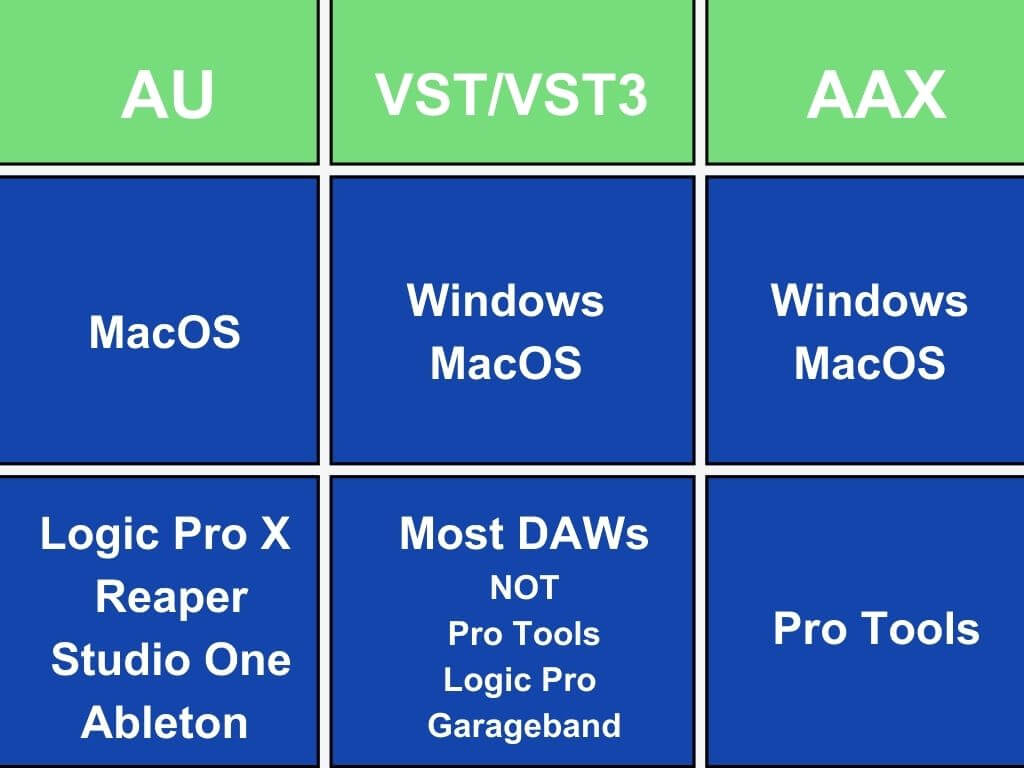VST, AU, and AAX: 3 common types of audio plugin formats
Plugins are vital extensions of our DAW software.
Whether you’re striving to be a singer-songwriter, a music producer, a sound designer, or a mix/master engineer – you will use plugins at some point or another.
But there are a few things you need to consider when deciding what the best plugin format is for you.
For example, are you a Windows or Mac user? Do you use Pro Tools, Logic Pro, or another DAW?
We’re exploring all of this and more with the following topics:
- What are plugins?
- Plugin formats for different operating systems
- The difference between the plugin formats
- Native plugins vs DSP plugins
- What plugin format should I use?
- What’s the best plugin format?
- FAQs
What are plugins?
In general terms, a plugin is an extension or additional software tool that you can install into a host software.
But what is a plugin in music?
So, in digital audio, an audio plugin is a software tool that you can insert into your host DAW software – a Digital Audio Workstation.
Furthermore, there are a few types of Digital Audio Workstation plugins. But most DAW plugins also allow you to run them in standalone mode – no matter the plugin format.
In any case, we can control these plugins with our mouse and keyboard or a MIDI controller.
Because different software companies make their trademark DAWs, they often have different specifications from others.
And because different big tech companies – Apple and Microsoft – make their own operating systems, they also have their own requirements.
For example, Apple’s DAWs – Logic Pro and Garageband – can only read the AU plugin format. And even Apple’s macOS could only read AU plugins until not so long ago!
However, Avid’s DAW Pro Tools can only read AAX plugins.

In other words, audio plugin formats are associated with different DAWs and operating systems. As a result, there are different types of audio plugin formats.
Plugin formats for different operating systems
That brief introduction shows you that the battle of the operating systems – Windows and macOS – affects musicians and music producers as it does the general consumer.
Plugins for Windows
The common plugin format for Windows is VST/VST3. Unlike AAX and AU plugin formats, the VST format is pretty much universal.
However, AAX plugins are compatible with Windows operating systems too. But Pro Tools is the only DAW that can read this format.
Plugins for macOS
Once upon a time, macOS could only read AU plugins and not VST.
Now though, macOS can read VST and AAX plugins too. Many Mac users make music with Logic Pro X, so AU plugins are their go-to plugin format.
And the AU format remains the standard plugin format that Apple systems read, despite how they can read VST plugins now too.
Why? Well, let’s dive into the specifics…
The difference between the plugin formats
At this point, you’re probably asking yourself “surely there are reasons we have all these plugin formats that don’t concern operating systems?”
Aside from AAX, the biggest difference between the VS and AU plugin formats was the fact that macOS only read AU plugins for the longest while.
What are VST plugins?
VST stands for Virtual Studio Technology and they’re compatible with most DAWs except Pro Tools.
But you can use VST plugin instruments standalone without a DAW, whether it’s a VST synthesizer or a sample-based VST intrument.
In short, they are the most popular plugin format there is. Whether for virtual instruments or effects, the VST format is the most widely known plugin format.
As a matter of fact, “VST instruments and plugins” has become the common way to discuss “virtual instruments and plugins“. “VST instruments” and “virtual instruments” are used interchangeably!
In practice, you can use VST plugins in DAWs such as Ableton Live, FL Studio, Cubase, and so many more.
Steinberg released the VST format in 1996 with their DAW Cubase. At that time VSTs only worked with Windows. Now, though, they work with both Windows and macOS.
Since 1996 it has gone on to become the industry standard plugin format.
Make way for VST3…
VST3 (version 3.02) is the latest iteration of the VST plugin format.
VST3 plugins use 64-bit processing, unlike VST plugins which use 32-bit processing.
The biggest difference between this version and the previous VST formats is how VST3 plugins only add processing when an audio signal is playing.
Despite this, some plugins are still available as VST 2.0 and 2.4.But these 32-bit plugins are being phased out because they don’t work with many new DAW updates.
So, what are AU plugins?
The AU plugin format – which stands for Audio Unit – is Apple’s proprietary audio technology. More specifically, the tech giant made the AU plugin format themselves.
Therefore AU plugins are made to work with macOS specifically. And the format is part of the Core Audio provided by macOS – the AU format is part of the macOS operating system!
So it makes sense that Logic Pro/Logic Pro X and Garageband only read AU plugins as these are Apple products too.
Despite its exclusivity, the AU plugin format provides very low latency and stability (and therefore faster processing) for users.
With that said, other DAWs such as Ableton Live, Reaper, and Studio One now supports AU plugins too!
What are AAX plugins? The plugin format for Pro Tools
AAX stands for Avid Audio Extension. And Avid introduced this plugin format because they designed a 64-bit version of Pro Tools.
As a result, they needed a plugin format that could handle 64-bit processing in their DAW. But AAX plugins only work with Pro Tools and no other DAW.
Though its exclusive, the AAX format allows you to share sessions between different instances of 64-bit-enabled Pro Tools DAWs and continue using the same plugins with all settings in place.
Native plugins vs DSP plugins
All plugins are divided into two categories no matter the plugin format. These categories are native plugins and DSP plugins. And what differentiates them is how they draw power from the computer they’re installed on.
A native plugin draws power from the computer’s CPU (processor).
And DSP plugins draw power from a separate processor which can be an audio interface.
Native plugins are far more common, despite how a DSP plugin could save our computer system a lot of work.
Although a native plugin shouldn’t cause any issues if you have a processor capable of the heavy task of music production – an Intel i5 or equivalent.
What plugin format should I use?
Now that you’re an expert on how plugins work, it’s time to think about what determines the plugin format that works for you.
To do so, you’ll have to ask yourself a few questions.
- Do you use Windows or Mac?
If you’re a Windows user then install VST plugins. On the contrary, if you’re a MAC user then install AU plugins.
Although Mac now supports VST plugins, AU plugins give Mac users a better user experience. - Does your DAW support the VST format?
If so, use VST plugins. Well, unless… - Does your DAW support VST3?
Always use VST3 plugins if your DAW supports them. If your DAW doesn’t currently support VST3 but does support VST then install both. Your software DAW will inevitably support VST3 in the future. - Are you a Pro Tools user?
If you’re using Pro Tools then always install AAX plugins.
Final thoughts: what’s the best plugin format?
Thanks to their almost universal application, VST3 is the best plugin format in my opinion. Now, VST plugins run on both Mac and Windows, in addition to almost every DAW excluding Pro Tools.
But Apple’s AU plugin format works wonders on Mac computers. Their stability and low latency processing make them a steal if you’re a Mac user (which I am not).
Finally, AAX plugins allow Pro Tools users to share their projects with other PT users without losing any information in the transfer.
So if you’re a Pro Tools user or a Mac user then VST plugins may not be the best plugin.
But if you use any other DAW outside of Logic Pro or Pro Tools on a Windows system then VST plugins are the plugin format for you.
FAQs
Do VST plugins work in Pro Tools?
No, VST plugins do not work in Pro Tools. AAX plugins are a specific plugin format for the Pro Tools DAW.
Does a VST work with Garageband?
VST plugins do not work in Apple’s Garageband. Garageband users must use AU plugins.
Do VST plugins work in Logic?
Like Garageband, VST plugins do not work in Logic Pro. If you’re a Logic Pro user then you must use AU plugins.
Do VST work on Mac?
VST3 plugins now work on Mac. However, AU plugins will provide you with more stability on Mac systems than VST plugins.
What benefits do VSTs offer over AU and AAX?
If you’re a Mac user or you make music on Pro Tools then VST plugins will not provide you with any real benefits.
However, if you’re a Windows user with a DAW that is not Pro Tools then VST plugins seamlessly integrate software synthesizers, software instruments, and audio effects into your DAW.
How do VST plugins work?
Virtual instruments use samples or algorithms to generate sound (or both) while audio effects apply processing to digital audio signals at their input. Then, the effect outputs the signal with the new processing applied.
On the user end, we can use MIDI controllers to control VST plugins such as virtual instruments and audio effects with physical faders and knobs to control the tone of the instrument sound or intensity of the effect.
